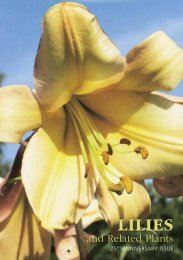Lilies and Related Plants - RHS Lily Group
Lilies and Related Plants - RHS Lily Group
Lilies and Related Plants - RHS Lily Group
You also want an ePaper? Increase the reach of your titles
YUMPU automatically turns print PDFs into web optimized ePapers that Google loves.
Figure 10. The 4 th seedling to flower<br />
was spidery.<br />
Figure 11. Bulbs taken out of tissue<br />
culture, trimmed <strong>and</strong> vernalized in<br />
damp cedar chips.<br />
less. The bulbs are up to 1 inch across, fragile, with scales poking out into harm’s<br />
way. The scales are jointed in 1 to 3 locations <strong>and</strong> break off with little effort. Those<br />
tiny bits of scale generate multiple bulblets when put back into tissue culture.<br />
L . philadelphicum var. <strong>and</strong>inum has long <strong>and</strong> narrow seed pods which are quite<br />
uniform while the hybrid seed pods are fatter <strong>and</strong> shorter <strong>and</strong> shape <strong>and</strong> size varies<br />
from plant to plant. Like L . philadelphicum, these can set lots of good looking<br />
small seeds with very little chaff although I only got a dozen or so seeds from one<br />
pod. A couple of pods contained over 200 seeds.<br />
A few final thoughts<br />
I expect the F2 generation will produce a wider range of variation. F2 seed has<br />
already been obtained <strong>and</strong> will be sent to the <strong>RHS</strong> <strong>and</strong> NALS seed exchanges this<br />
year. This seed is the result of intercrossing the plants shown in the photos. I would<br />
like to encourage others to grow these hybrids from seed <strong>and</strong> to share the resulting<br />
plants <strong>and</strong> seeds with others to ensure long term survival of this material. The<br />
seed should be easy to start if exposed to light <strong>and</strong> moisture. There is no need to<br />
start seed in vitro but I would like to mention that the in vitro approach is a good<br />
way to start the seed. This approach gives near 100% germination with few losses,<br />
it gets plants past the juvenile stage where damp off <strong>and</strong> such can strike down the<br />
seedlings, <strong>and</strong> plants initially grow faster than they would in soil. A full account of<br />
this in vitro approach can be found in the June 1, 2011 issue of the North American<br />
<strong>Lily</strong> Society Quarterly Bulletin (Vol 65, No. 2, page 19), the article is titled, An in<br />
Vitro Germination Experiment with L . philadelphicum <strong>and</strong> L . philadelphicum ×<br />
L . catesbaei. If anyone has additional questions about the hybrids or about growing<br />
from seed, or comments in general, feel free to contact me at bfrncs@bepc.com.<br />
17




